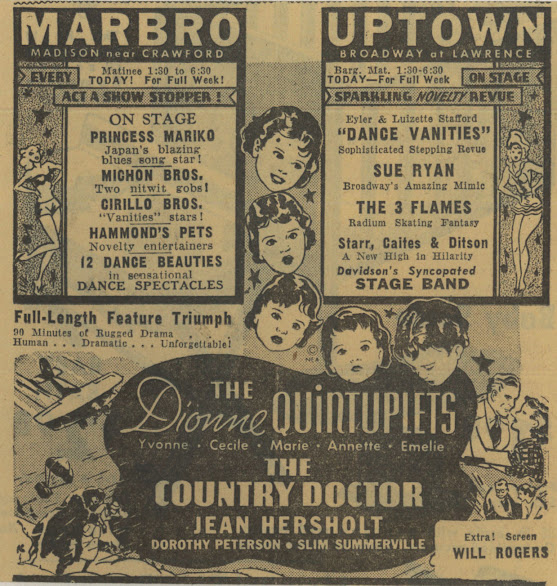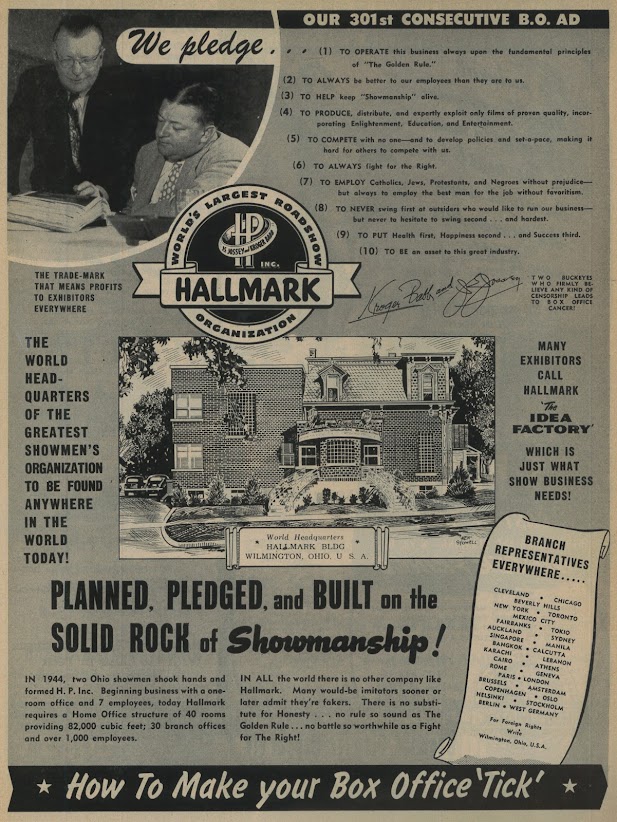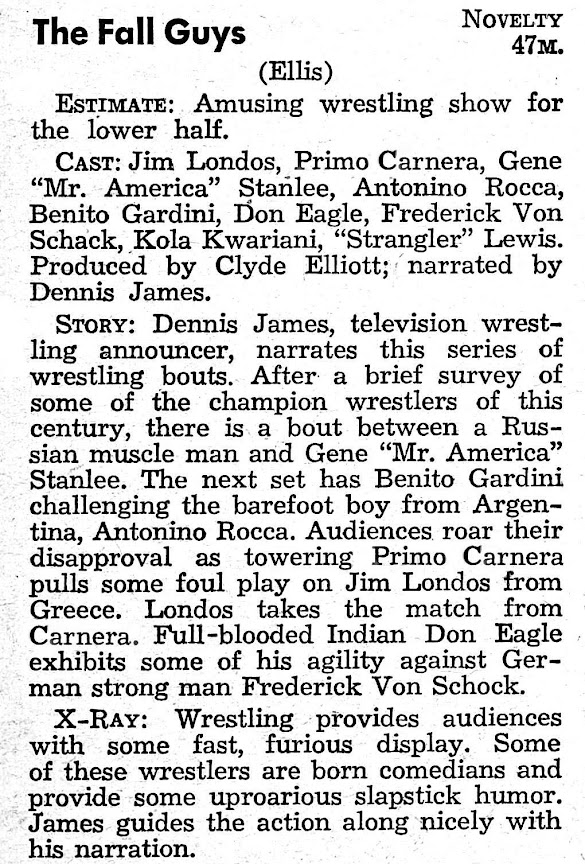Inspired by Greenbriar Book of the Same Name ...
The Art of Selling Movies #1 --- Carolina, The Country Doctor, and The Fan
CAROLINA (1934) --- At left is what they used to call a “mini-window card.” Sample shown is apx. 8X11, a blank margin likely trimmed off at some point. Idea was to print or hand-write playdates in the white space, then post cards on cooperating store windows. Merchants used to assist one another that way. A Fox Films production and release before the merger that birthed Twentieth Century Fox, Carolina was gone for a lot of years and essentially still is, though eagle eyes will find it streaming here and there. Carolina is of plantation drama school, based on a play put on by Group Theatre members, or future members of same. None of creatives apart from director Henry King seem Southern, Janet Gaynor, Lionel Barrymore, Robert Young, others of Carolina cast. I wonder if King and John Ford flipped a coin over which would direct. However way, King won. Think what Griffith could have done with this. He was but a couple of years past his last feature when Carolina went before cameras. Would it have been so beyond likelihood for Fox to hire him? Especially for a project so ideally suited to him. As it is, Henry King may well have looked to DWG example when he composed shots for Carolina. What more likely informed him was likes of Only the Brave, a less serious treatment of war and loss, the theme dated since nineteenth cent stages wore it out. What Carolina captures is grievances if not glory active for decades past conflict, the Lionel Barrymore character reflective of real lives never the same after shooting stopped. Pity the film is so barely known, even if no rediscovered classic. In fact, Carolina is anything but sought after. Hard to imagine it being programmed anywhere, even given freer access. A surviving print (the only one?) is held by the George Eastman House. There are a lot of jump splices with sound occasionally motorboating.
Gaynor plays as Gaynor generally played. I kind of get why audiences tired of her. She’s a Yankee with southern antecedents who wants to grow tobacco on gone-to-ruin grounds owned by a family living on past we flashback to, balls attended by Thomas Jefferson, Stonewall Jackson, and Robert E. Lee (all at once!). Lionel Barrymore as former combatant for the Confederacy hallucinates to spooky effect that Gaynor is a lost Ante-Bellum love. She, along with Robert Young represents attitude changing and by a finish, winning. Once-granduer falling down around them signals a family spent and better served by youth that might at least salvage something. Shooting was at what looks like real crumbled South setting (was it?), a boost to conviction. Ceilings seem thirty feet high and most look real rather than glass shots. Director King emphasizes ceilings. Had dwellers built them high so sweltering heat would rise above people having to breathe it? I’ll guess King scoped out an ideal location near his own ancestral home (Virginia) and maybe flew cast/crew in his private plane to do the job. How many ante-B Southern mansions are left? There’s still one in my family. I could shoot a remake of Carolina there. A happy ending finds folk prospering at tobacco growth and making industry of it, which my great-grandfather did in real life. Someday I must write about him and the movie I’m convinced was based on his story, Bright Leaf. Carolina came up in ante-bellum days of Greenbriar (February 23, 2006), our Allen Theatre having brought it back in 1941 to compete with the Liberty’s big vaudeville show up the street. Maybe the Allen’s old nitrate print was what the Eastman House ended up with.
THE COUNTRY DOCTOR (1936) --- More Fox fan feeding, this two years after Carolina with Zanuck in charge and all eyes trained on ultimate freak act that was five babes born to a Canadian couple who, with delivering doctor, made quints pay and pay till mere mention of Dionnes on marquees was enough to fill auditoria. The Country Doctor was Henry King again at helm, rising above simple exploitation this project was. We can see it too, if not streaming then via DVD as still sold by “Fox Cinema Archive,” an on-demand service that surprisingly continues to service ones who care. It’s a variable lot quality-wise, but The Country Doctor looks OK, being very definition of obscure, but there’s no ignoring sensation those five girls were from infancy on. There have been books since, dark accounts of greed and such, to read in event you seek to be bummed out. Two of the Quints remain, ninety now (born 5/34). Plenty of them and sisters are in The Country Doctor, ergo admissions paid to see an otherwise programmer. It would be Fox’s biggest profit picture of 1936, next to whatever Shirley Temple was up to. Jean Hersholt is the title character. William K. Everson said Will Rogers would have had the part had he been alive. Director King makes this a good picture even without the kids. Once they arrive (a six reel wait), it’s quint-essential we focus on them for remainder of running time. Marbro and Uptown patrons would surely have insisted on that. These Dionnes were rock stars of their day, like five Taylor Swifts lined up. Note bonus short with The Country Doctor --- simply “Will Rogers” as in further words superfluous. Grieving still was going on, his features to be reissued, funds set up in his name. The Dionnes would be back as well on same terms, a short and two features, all for Fox. Here was one company that knew how to bleed rocks.
THE FAN (1949) --- You can take Oscar Wilde off the page, but you can’t take the page off Oscar Wilde, there being awkward proof I’ll never be Oscar Wilde, but neither would Fox for talkie go at Lady Windemere’s Fan, Ernst Lubitsch having lent inimitable touch to it in silent days, that silent part the cancel to Wilde wit we expect, though still good for visual wit that was Lubitsch’s alone. You can see his Fan on one of those silent treasure DVD collections, and the ‘49 remake from Fox Cinema Archive (quality quite good). Otto Preminger directed the talker, his go not too well regarded it seems, though I ended up liking it despite restless moments. Had Lubitsch lived, he would surely have done this, having been at Fox employ for 40’s most part, The Fan a second time Preminger succeeded to projects associated with Lubitsch. A cast is fine: Jeanne Crain, Madeleine Carroll, George Sanders, Richard Greene … Sanders has a gorgeous scene, played utterly sincere, where he pleads with Crain to leave her husband and run away with him. Pictures like The Fan would not have a whole lot of time left. In fact, its time was already past, $1.4 million spent on the negative, a ruinous $450K in domestic rentals, worse $283K foreign. Loss to Fox was a million, not that they weren’t losing as much on others ’49 released, and conditions would only get worse. Look here at the Roxy splash it had, confidence unbound, but then Fox was same-way about Unfaithfully Yours. The Fan as a story was fine, and undoubtedly worked swell on the stage. How could the play miss when new, Oscar Wilde coming out to take bows and tell the audience what good taste they showed for making it a hit. Would Oscar have liked any aspect of either version of Lady Windemere’s Fan? He didn’t live long enough to experience movies, around till 1900 it’s true, but broken before that by imprisonment and being ostracized after. He put a lot that was good into Lady Windemere’s Fan, and the two films made from it (are there more?) couldn’t help glowing at times thanks to him.
UPDATE -- 11/25/2024 --- Scott MacGillivray supplies further and much appreciated data on the Will Rogers newsreels before and after his death.
Hi, John — The “Extra! Will Rogers” mentioned in your newspaper ad is one of the Rogers one-reelers originally released by Pathé in 1927. These were travelogues chronicling a flying tour through various international destinations. Amity Pictures reissued them in 1934, presumably without Rogers’s participation. I can’t imagine a small states-rights distributor paying Rogers his current salary to record new spoken soundtracks for these shorts.
After Rogers died, Fox was deluged with exhibitor requests for the Rogers features, but Fox denied all of them out of respect for his recent passing. Fox honored repeat bookings one year after his death.
Amity’s 1934 purchase of the Rogers shorts was during Pathé’s fire sale. The company was then selling off its film backlog, and that’s when Harold Lloyd bought back whatever Lonesome Lukes and early Lloyd reels were still on hand.


































